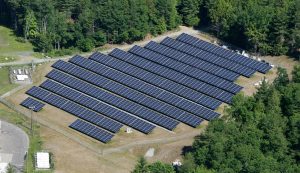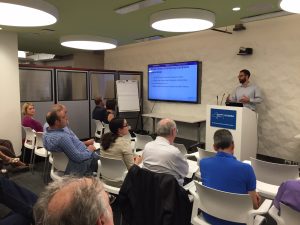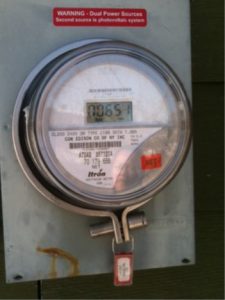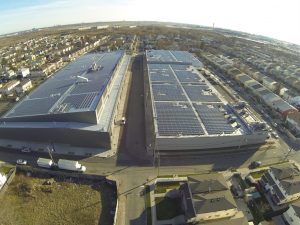June 30, 2016
by Pamela Berns

According to Dennis Phayre of
EnterSolar, even if we utilized all currently available sources, we’d only have about 100 years of energy left on the planet. But New York State isn’t waiting one more second to embark on innovative partnerships that will not only extend that timeframe but also significantly reduce the State’s carbon footprint.
On June 15, at the host offices of the
New York State Energy Research & Development Authority (NYSERDA), GreenHomeNYC introduced three key players in these new collaborations for an instructive and exciting program about community solar. Community solar brings together customers, utilities, solar companies, and the state government to develop an interconnected approach to electrical power that will not only impact the way in which we create and move energy, but also the way in which consumers participate in the energy marketplace.

Max Joel is a Program Manager for Community Solar NY, a part of the
NY-Sun Initiative, a statewide solar initiative whose goal is to expand the deployment of solar capacity throughout the state to build a self-sustaining solar market. NY-Sun is one of several programs within NYSERDA aimed at realizing the state’s energy efficiency and sustainability goals. Alison Kling is a Senior Specialist in the Distributed Generation group at
Con Edison, where she focuses on solar customer communications, process improvements, and long-term policy changes for interconnection. Dennis Phayre is Business Development Director at EnterSolar, and is focused on PV project origination, site assessment, incentive and financial analysis, and proposal delivery.
According to Joel, the NY-Sun program reports that growth in the solar business in New York State is unprecedented, having increased 575% from 2012 to 2015. The number of megawatts installed (525) is already enough to power nearly 85,000 homes. New York State’s
Reform the Energy Vision (REV) program is “Governor Cuomo’s strategy to build a clean, resilient and affordable energy system,” and community solar is becoming an integral feature. It is made possible by taking advantage of a proposed new net metering structure to allow “any utility customer to be a subscribing member, and receive credit on their bill” for power sent back to the grid, said Joel. This means that solar can be developed in one section of the city, be it a large roof or an abandoned field, and sold back into the grid to be used by others on that same grid. Plus, said Kling, “New York City is a very renter oriented real estate market. This is a way to help make renters a part of it.” According to Joel, shared solar also enables building owners to increase income by leasing roof space and diversifying their income streams.
The Role of the Grid
As Joel so aptly points out, “Just because you have solar doesn’t mean the grid goes away. You can’t do it without the grid.” Here’s how it works: Any utility customer within a single utility and
NY-ISO zone may be a member of a project. Each individual member’s share of the energy production appears as a credit on their monthly utility bill. The solar

project or farm is installed at a remote site, and the utility manages the distribution of energy on the grid. In a nutshell, according to Kling, the utility’s role in solar interconnections is to maintain grid safety and reliability for all customers, install net meters, implement subsequent billing, and integrate Distributed Energy Resources (DERs) into load planning and forecasts. Each project also has a sponsor who owns or operates the project, organizes the membership, and interfaces with the utility. A sponsor may be the project developer, a private company, or other entity. Its role is to provide the utility with a list of members and their percent allocation of the credits prior to interconnection, and then to recruit, manage and track membership in the ongoing concern.
To help the audience understand how the grid fits into the process, Kling explained the basics of how Con Ed’s grid works. The Con Ed grid, which supplies electricity to Westchester County as well as the five boroughs, leverages 83 underground service grids to support a mesh network of systems that support “built in redundancy and reliability.” As a result, outages in one part of the system are addressed by checks and balances in another, which enables power to be delivered to customers seamlessly and uninterrupted. But the system also contains network protectors against the backward flow of electricity, which made sense before small scale, on-site power generation was introduced into the mix. The problem is that when solar flows into the system in a “backward” direction, the system “thinks” something is wrong and shuts down, says Kling. To enable community solar, she says, the utility “comes in and puts in new meters that go backward and forward. That’s when the magic happens.” She says Con Ed is responsible for ensuring that solar is “integrated in the best way,” and enabling solar power to “export into our system.”
Planting the First New York State Community Solar Farm
EnterSolar is currently constructing the first community solar project in New York State at a site in Halfmoon, NY, located in Upstate New York. The array will feed solar energy to the grid operated by
New York State Electric & Gas (NYSEG), and will allow more than 100 residential customers, including low-income residents, to participate in community shared solar. Until now, the company has focused its projects on businesses, and boasts Bloomberg and Target as two of its biggest customers.

According to Phayre, the remote net metered Bloomberg project brings solar credits to two Bloomberg buildings in Manhattan from an installation at a site near JFK airport; the credits are utilized in the Manhattan buildings and “transferred to facilities elsewhere.” Likewise, says Phayre, “community solar lets us take solar from one source and distribute it to hundreds of others,” and sees it as a “large-scale” business proposition that equals that of the Bloomberg project. He noted that a project the size of the Bloomberg system could power as many as 250 residences.
An existing EnterSolar remote net metering site in Halfmoon, NY supplies power to seventeen Stewart’s Shops in the region, and serves as a model for the community solar project. As he projected a slide of the Stewart’s solar farm in Halfmoon, Phayre pointed out the importance of choosing land responsibly. “This was a hayfield before we built the solar farm on it, so the impact on the land is not great. It’s an eco-friendly installation…it almost looks like an apple orchard.”
Systems Thinking in Energy
In the complex web of the renewables marketplace, utilities, solar companies, sponsors, and customers are joined by additional stakeholders and technologies. “Net metering [alone] doesn’t create a smart grid,” Phayre reminded the audience. “Regulations are critical for creating markets.” Tax incentives also feed the machine, and at the time of this writing, the two-year extension of New York City’s solar property tax credit was eagerly awaiting signature in Albany.
In response to an audience question about the roles of micro-grids, battery storage, and energy efficiency, all three speakers agreed that ultimately there will be a place for all of these. “If you can reduce the use of energy, that’s the biggest win of all,” said Phayre. And while energy efficiency is not obligated for membership in the community solar program, “it will become a big business opportunity.” Phayre sees community solar as the “democratization of solar,” and he also emphasized business pragmatism as a key driver in the whole process. After all, “if you’re going to spend money, you want that money to be well-spent.”
 According to Dennis Phayre of EnterSolar, even if we utilized all currently available sources, we’d only have about 100 years of energy left on the planet. But New York State isn’t waiting one more second to embark on innovative partnerships that will not only extend that timeframe but also significantly reduce the State’s carbon footprint.
On June 15, at the host offices of the New York State Energy Research & Development Authority (NYSERDA), GreenHomeNYC introduced three key players in these new collaborations for an instructive and exciting program about community solar. Community solar brings together customers, utilities, solar companies, and the state government to develop an interconnected approach to electrical power that will not only impact the way in which we create and move energy, but also the way in which consumers participate in the energy marketplace.
According to Dennis Phayre of EnterSolar, even if we utilized all currently available sources, we’d only have about 100 years of energy left on the planet. But New York State isn’t waiting one more second to embark on innovative partnerships that will not only extend that timeframe but also significantly reduce the State’s carbon footprint.
On June 15, at the host offices of the New York State Energy Research & Development Authority (NYSERDA), GreenHomeNYC introduced three key players in these new collaborations for an instructive and exciting program about community solar. Community solar brings together customers, utilities, solar companies, and the state government to develop an interconnected approach to electrical power that will not only impact the way in which we create and move energy, but also the way in which consumers participate in the energy marketplace.
 Max Joel is a Program Manager for Community Solar NY, a part of the NY-Sun Initiative, a statewide solar initiative whose goal is to expand the deployment of solar capacity throughout the state to build a self-sustaining solar market. NY-Sun is one of several programs within NYSERDA aimed at realizing the state’s energy efficiency and sustainability goals. Alison Kling is a Senior Specialist in the Distributed Generation group at Con Edison, where she focuses on solar customer communications, process improvements, and long-term policy changes for interconnection. Dennis Phayre is Business Development Director at EnterSolar, and is focused on PV project origination, site assessment, incentive and financial analysis, and proposal delivery.
According to Joel, the NY-Sun program reports that growth in the solar business in New York State is unprecedented, having increased 575% from 2012 to 2015. The number of megawatts installed (525) is already enough to power nearly 85,000 homes. New York State’s Reform the Energy Vision (REV) program is “Governor Cuomo’s strategy to build a clean, resilient and affordable energy system,” and community solar is becoming an integral feature. It is made possible by taking advantage of a proposed new net metering structure to allow “any utility customer to be a subscribing member, and receive credit on their bill” for power sent back to the grid, said Joel. This means that solar can be developed in one section of the city, be it a large roof or an abandoned field, and sold back into the grid to be used by others on that same grid. Plus, said Kling, “New York City is a very renter oriented real estate market. This is a way to help make renters a part of it.” According to Joel, shared solar also enables building owners to increase income by leasing roof space and diversifying their income streams.
The Role of the Grid
As Joel so aptly points out, “Just because you have solar doesn’t mean the grid goes away. You can’t do it without the grid.” Here’s how it works: Any utility customer within a single utility and NY-ISO zone may be a member of a project. Each individual member’s share of the energy production appears as a credit on their monthly utility bill. The solar
Max Joel is a Program Manager for Community Solar NY, a part of the NY-Sun Initiative, a statewide solar initiative whose goal is to expand the deployment of solar capacity throughout the state to build a self-sustaining solar market. NY-Sun is one of several programs within NYSERDA aimed at realizing the state’s energy efficiency and sustainability goals. Alison Kling is a Senior Specialist in the Distributed Generation group at Con Edison, where she focuses on solar customer communications, process improvements, and long-term policy changes for interconnection. Dennis Phayre is Business Development Director at EnterSolar, and is focused on PV project origination, site assessment, incentive and financial analysis, and proposal delivery.
According to Joel, the NY-Sun program reports that growth in the solar business in New York State is unprecedented, having increased 575% from 2012 to 2015. The number of megawatts installed (525) is already enough to power nearly 85,000 homes. New York State’s Reform the Energy Vision (REV) program is “Governor Cuomo’s strategy to build a clean, resilient and affordable energy system,” and community solar is becoming an integral feature. It is made possible by taking advantage of a proposed new net metering structure to allow “any utility customer to be a subscribing member, and receive credit on their bill” for power sent back to the grid, said Joel. This means that solar can be developed in one section of the city, be it a large roof or an abandoned field, and sold back into the grid to be used by others on that same grid. Plus, said Kling, “New York City is a very renter oriented real estate market. This is a way to help make renters a part of it.” According to Joel, shared solar also enables building owners to increase income by leasing roof space and diversifying their income streams.
The Role of the Grid
As Joel so aptly points out, “Just because you have solar doesn’t mean the grid goes away. You can’t do it without the grid.” Here’s how it works: Any utility customer within a single utility and NY-ISO zone may be a member of a project. Each individual member’s share of the energy production appears as a credit on their monthly utility bill. The solar  project or farm is installed at a remote site, and the utility manages the distribution of energy on the grid. In a nutshell, according to Kling, the utility’s role in solar interconnections is to maintain grid safety and reliability for all customers, install net meters, implement subsequent billing, and integrate Distributed Energy Resources (DERs) into load planning and forecasts. Each project also has a sponsor who owns or operates the project, organizes the membership, and interfaces with the utility. A sponsor may be the project developer, a private company, or other entity. Its role is to provide the utility with a list of members and their percent allocation of the credits prior to interconnection, and then to recruit, manage and track membership in the ongoing concern.
To help the audience understand how the grid fits into the process, Kling explained the basics of how Con Ed’s grid works. The Con Ed grid, which supplies electricity to Westchester County as well as the five boroughs, leverages 83 underground service grids to support a mesh network of systems that support “built in redundancy and reliability.” As a result, outages in one part of the system are addressed by checks and balances in another, which enables power to be delivered to customers seamlessly and uninterrupted. But the system also contains network protectors against the backward flow of electricity, which made sense before small scale, on-site power generation was introduced into the mix. The problem is that when solar flows into the system in a “backward” direction, the system “thinks” something is wrong and shuts down, says Kling. To enable community solar, she says, the utility “comes in and puts in new meters that go backward and forward. That’s when the magic happens.” She says Con Ed is responsible for ensuring that solar is “integrated in the best way,” and enabling solar power to “export into our system.”
Planting the First New York State Community Solar Farm
EnterSolar is currently constructing the first community solar project in New York State at a site in Halfmoon, NY, located in Upstate New York. The array will feed solar energy to the grid operated by New York State Electric & Gas (NYSEG), and will allow more than 100 residential customers, including low-income residents, to participate in community shared solar. Until now, the company has focused its projects on businesses, and boasts Bloomberg and Target as two of its biggest customers.
project or farm is installed at a remote site, and the utility manages the distribution of energy on the grid. In a nutshell, according to Kling, the utility’s role in solar interconnections is to maintain grid safety and reliability for all customers, install net meters, implement subsequent billing, and integrate Distributed Energy Resources (DERs) into load planning and forecasts. Each project also has a sponsor who owns or operates the project, organizes the membership, and interfaces with the utility. A sponsor may be the project developer, a private company, or other entity. Its role is to provide the utility with a list of members and their percent allocation of the credits prior to interconnection, and then to recruit, manage and track membership in the ongoing concern.
To help the audience understand how the grid fits into the process, Kling explained the basics of how Con Ed’s grid works. The Con Ed grid, which supplies electricity to Westchester County as well as the five boroughs, leverages 83 underground service grids to support a mesh network of systems that support “built in redundancy and reliability.” As a result, outages in one part of the system are addressed by checks and balances in another, which enables power to be delivered to customers seamlessly and uninterrupted. But the system also contains network protectors against the backward flow of electricity, which made sense before small scale, on-site power generation was introduced into the mix. The problem is that when solar flows into the system in a “backward” direction, the system “thinks” something is wrong and shuts down, says Kling. To enable community solar, she says, the utility “comes in and puts in new meters that go backward and forward. That’s when the magic happens.” She says Con Ed is responsible for ensuring that solar is “integrated in the best way,” and enabling solar power to “export into our system.”
Planting the First New York State Community Solar Farm
EnterSolar is currently constructing the first community solar project in New York State at a site in Halfmoon, NY, located in Upstate New York. The array will feed solar energy to the grid operated by New York State Electric & Gas (NYSEG), and will allow more than 100 residential customers, including low-income residents, to participate in community shared solar. Until now, the company has focused its projects on businesses, and boasts Bloomberg and Target as two of its biggest customers.
 According to Phayre, the remote net metered Bloomberg project brings solar credits to two Bloomberg buildings in Manhattan from an installation at a site near JFK airport; the credits are utilized in the Manhattan buildings and “transferred to facilities elsewhere.” Likewise, says Phayre, “community solar lets us take solar from one source and distribute it to hundreds of others,” and sees it as a “large-scale” business proposition that equals that of the Bloomberg project. He noted that a project the size of the Bloomberg system could power as many as 250 residences.
An existing EnterSolar remote net metering site in Halfmoon, NY supplies power to seventeen Stewart’s Shops in the region, and serves as a model for the community solar project. As he projected a slide of the Stewart’s solar farm in Halfmoon, Phayre pointed out the importance of choosing land responsibly. “This was a hayfield before we built the solar farm on it, so the impact on the land is not great. It’s an eco-friendly installation…it almost looks like an apple orchard.”
Systems Thinking in Energy
In the complex web of the renewables marketplace, utilities, solar companies, sponsors, and customers are joined by additional stakeholders and technologies. “Net metering [alone] doesn’t create a smart grid,” Phayre reminded the audience. “Regulations are critical for creating markets.” Tax incentives also feed the machine, and at the time of this writing, the two-year extension of New York City’s solar property tax credit was eagerly awaiting signature in Albany.
In response to an audience question about the roles of micro-grids, battery storage, and energy efficiency, all three speakers agreed that ultimately there will be a place for all of these. “If you can reduce the use of energy, that’s the biggest win of all,” said Phayre. And while energy efficiency is not obligated for membership in the community solar program, “it will become a big business opportunity.” Phayre sees community solar as the “democratization of solar,” and he also emphasized business pragmatism as a key driver in the whole process. After all, “if you’re going to spend money, you want that money to be well-spent.”
According to Phayre, the remote net metered Bloomberg project brings solar credits to two Bloomberg buildings in Manhattan from an installation at a site near JFK airport; the credits are utilized in the Manhattan buildings and “transferred to facilities elsewhere.” Likewise, says Phayre, “community solar lets us take solar from one source and distribute it to hundreds of others,” and sees it as a “large-scale” business proposition that equals that of the Bloomberg project. He noted that a project the size of the Bloomberg system could power as many as 250 residences.
An existing EnterSolar remote net metering site in Halfmoon, NY supplies power to seventeen Stewart’s Shops in the region, and serves as a model for the community solar project. As he projected a slide of the Stewart’s solar farm in Halfmoon, Phayre pointed out the importance of choosing land responsibly. “This was a hayfield before we built the solar farm on it, so the impact on the land is not great. It’s an eco-friendly installation…it almost looks like an apple orchard.”
Systems Thinking in Energy
In the complex web of the renewables marketplace, utilities, solar companies, sponsors, and customers are joined by additional stakeholders and technologies. “Net metering [alone] doesn’t create a smart grid,” Phayre reminded the audience. “Regulations are critical for creating markets.” Tax incentives also feed the machine, and at the time of this writing, the two-year extension of New York City’s solar property tax credit was eagerly awaiting signature in Albany.
In response to an audience question about the roles of micro-grids, battery storage, and energy efficiency, all three speakers agreed that ultimately there will be a place for all of these. “If you can reduce the use of energy, that’s the biggest win of all,” said Phayre. And while energy efficiency is not obligated for membership in the community solar program, “it will become a big business opportunity.” Phayre sees community solar as the “democratization of solar,” and he also emphasized business pragmatism as a key driver in the whole process. After all, “if you’re going to spend money, you want that money to be well-spent.”
